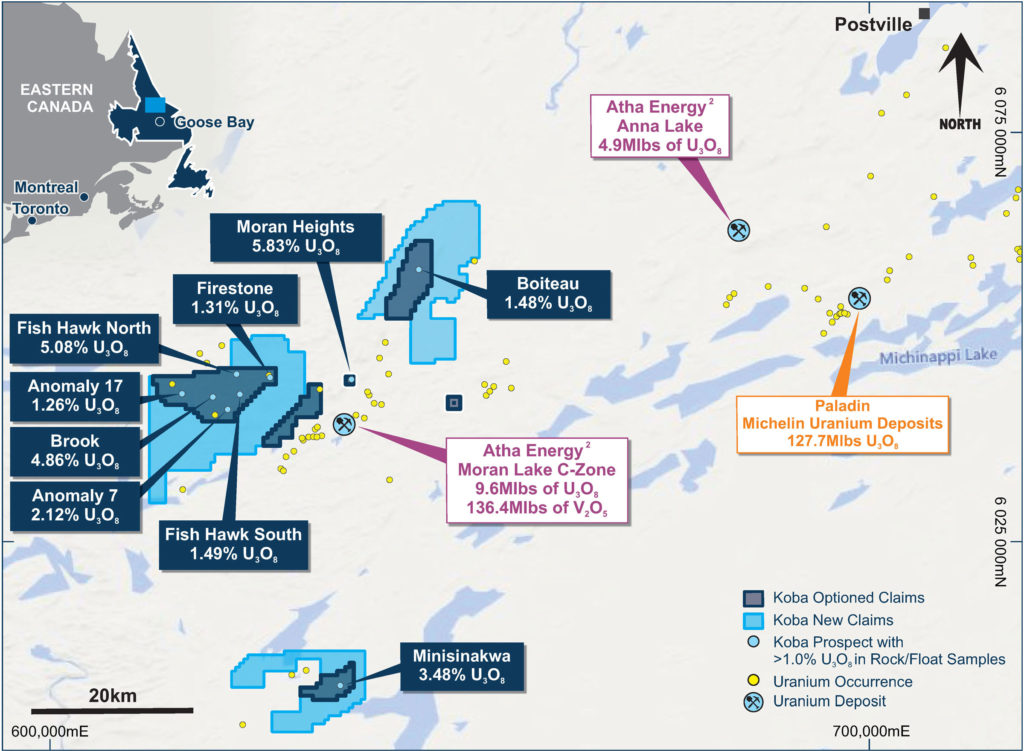The Harrier Uranium Project is located approximately 110km northwest of the regional hub of Goose Bay (population ~8,000) and 70km southwest of the small community of Postville in central Labrador within the province of Newfoundland and Labrador in eastern Canada (see Figure 1). It is located within an under-explored belt of Proterozoic and Archean aged rocks − part of a world class uranium district that hosts multiple significant uranium resources including:
- Paladin Energy’s Michelin Uranium Project which comprises six deposits that together host 127.7Mlbs of U3O8; and
- The Moran Lake and Anna Lake Deposits where historical resources comprise 14.5Mlbs U3O8 and 136.4Mlbs of V2O5.
The Harrier Project covers approximately 489km2 of highly prospective terrain. The project includes nine separate prospects from which extremely high-grade assays >1.0% U3O8 have been returned from rock chip samples (see Figure 1). This project is heavily underexplored as:
- Three of these prospects have never been drilled;
- Four of these prospects have been tested by 11 or less drill holes; and
- Across the entire project a total of only 89 holes have been drilled previously for 9,834m.

Figure 1. The Harrier Uranium Project lies within a world-class uranium district in eastern Canada. It includes nine prospects from which assays >1.0% U3O8 have been returned from rock chip samples.
Agreement with Azincourt Energy Corp
Koba Resources Limited has entered into agreements to assign its rights to a 100% interest in the Harrier Uranium Project in Newfoundland and Labrador, Canada, to Azincourt Energy Corp (TSXV:AAZ).
The terms agreed with Azincourt for the divestment of our Harrier Uranium Project in Canada provide Koba continued exposure to Azincourt’s success at the project which could crystallise significant value from the asset.
Importantly, this transaction allows Koba to maintain focus on its flagship 5,000km² Yarramba Uranium Project in South Australia, where we made three high-grade discoveries during our inaugural drilling program in 2024-2025.
These discoveries demonstrate the strong potential to discover additional uranium resources in a world class uranium district with significant mining infrastructure already in place.
Consideration payable to Koba for the granting of the Claim Option will comprise a series of cash payments and share issuances as follows:

Notes:
(1) Completion of the transaction is subject to approval from the TSX Venture Exchange (“TSXV”) and is expected to take place on or before 15 May 2025.
(2) Closing price of Azincourt common shares on the TSXV on 28 April 2025 was C$0.025, prior to the announcement of this transaction.
(3) All share issuances are subject to a 4-month statutory escrow period from the date of issue.
(4) The 10,000,000 shares issued on Closing are also subject to voluntary escrow restrictions, with a third of the shares released after each of 4, 8 and 12 months from the date of issue.
(5) Number of common shares issuable with respect to the 2nd and 3rd issuances is subject to adjustment in the event that the 20-day volume weighted average closing price of the common shares on the TSXV prior to the date of each such issuance exceeds C$0.05, pursuant to which such number of common shares shall be reduced and calculated as follows: C$250,000 divided by the 20-day volume weighted average closing price of the common shares on the TSXV prior to the date of such issuance.

